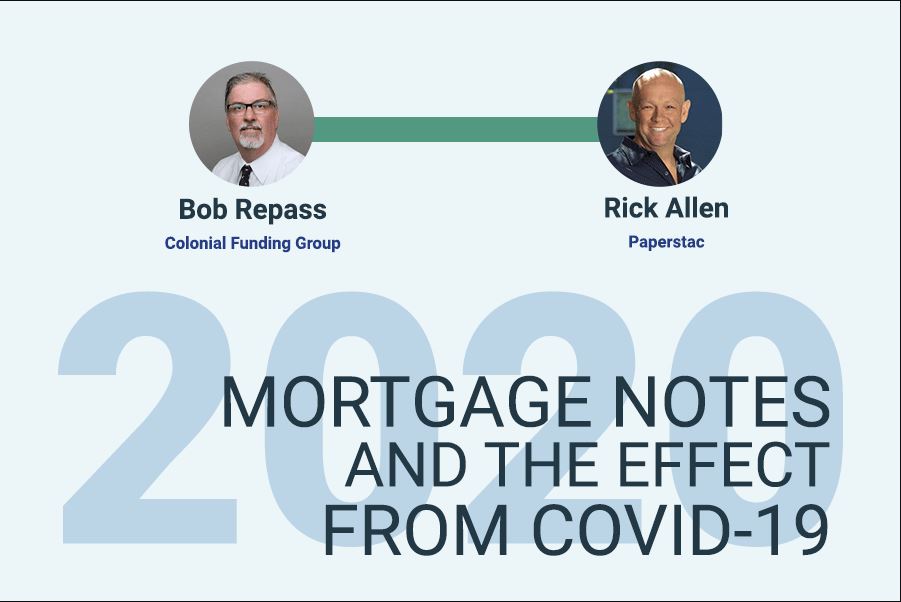
Thoughts from the Desk of Bob Repass…
I started in the seller finance discounted note business in 1990. I left my job as a bank manager and joined Metropolitan Mortgage & Securities who at the time were the largest institutional investor of privately held mortgages. After 2 weeks of training in Spokane, WA, I returned home to Raleigh NC to open up the East Coast for Metropolitan armed with a new HP 12-C (which I still have today) and a stack of Yellow Pages phone books as my marketing plan.
As you know, there was not much technology to help you scale your business in 1990. Sourcing inventory and deal flow has always been the key to who succeeds in the note business. Thankfully, times have changed. The impact of technology on the real estate note investing business has become more and more apparent over the last 5 years. To show this firsthand, the two leading, cutting edge online note trading platforms, NotesDirect and Paperstac, have teamed up to report on the trading activity during the first half of 2020.
My team and I here at NotesDirect joined Rick Allen and the Paperstac team and combined our data into a White Paper and Infographic providing mortgage note investors with insights on what took place during the first six months of trading activity.
The market for investing in mortgage notes changes from year to year. Still, usually there is a formula of predictability that acts as a crystal ball allowing investors to gauge how the coming months will play out. That is the case usually…enter 2020.
We are past the halfway point for 2020 and all formulas for predicting the future can be tossed out the window. We had a worldwide pandemic, the ultimate black swan event, come through like a wrecking ball and turn the world upside down. Businesses shut down, employees were furloughed or laid off, foreclosure and eviction moratoriums, and working remotely. Oh, did I mention that we are in an election year?
Investors want to know how to make sense of the current market, and what the coming months hold for mortgage note investors. Conventional wisdom says to look at the history books and see what the market did during a similar period; you know history repeats itself. Well, I looked and cannot find the guide to how this one will play out. Fortunately, we can still look back in history and get an idea of how the market reacted to COVID-19 and how it will play out.
While this mid-year report is excellent for understanding how the market reacted immediately to the pandemic, it also sets a benchmark that will be used for gauging the future. The findings in this report will be compared with the trading activity for the next 6 months and will be analyzed in the end of the year report for 2020, which is due out in late January 2021.
My key takeaway from the mid-year report was the fact that over $7.5mm in private capital was deployed between both platforms by mostly passive investors and although these are uncertain times, the findings in this report validate the continued appetite for passive investors to add real estate secured notes to their investment portfolios.
CLICK HERE to download the 2020 Mid-Year White Paper. I am very interested in hearing your thoughts and observations, you can email me at [email protected]. Thanks to Rick and his team at Paperstac.
Both NotesDirect and Paperstac will be sponsors of NoteExpo 2020. We invite you to plan on joining us November 6th & 7th by registering HERE and use the promo code: VIRTUAL to save $100. We’re looking forward to seeing you at this year’s virtual NoteExpo 2020.
Bob Repass
Managing Director
Stay up to Speed with Eddie
It’s Great To Ride The Equity Up, But Why Ride It Back Down?
by Eddie Speed
You can leave the house with the sun shining in the morning, but it’s pouring down rain in the afternoon. You gotta check the forecast or you could get soaked. Well, the same thing can happen to your net worth if you don’t make the right preparations.
With today’s market conditions, you can lose a huge chunk of your net worth if you’re not prepared. Many investors think everything is fine, but they have a serious problem that’s not even on their radar.
It happens when your rental property values take a nose-dive in a declining market. I can’t fix the market, but I can share wealth strategies for structuring your financing to maintain your net worth.
Last week, I met with a good friend who owns about 120 rental properties. The net worth of his rental portfolio alone is in the 8 digits, plus he has additional net worth from multiple tentacles in other areas of the industry.
He asked me what I thought he should do with his extensive rental portfolio in view of where the market is going (not simply where it is right now). He asked me, “Should I keep ‘em and rent ‘em, or sell ‘em and note ‘em?” Funny thing is, he was the fifth person to ask me that exact same question in the same week!
He said most of his houses are typically valued at around 200K, and he owes about 80K per house. That gives him an average of 120K in equity per house. Multiply that times 120 houses and it’s a hefty number.
I drew all the figures on my trusty whiteboard to answer his question and explain what was happening.
Most industry experts like Fannie Mae, Freddie Mac, FHA, and CoreLogic are predicting a decline in home values through 2021. The amount of decline will vary widely by market.
Why are they forecasting this big decline? Right now, there are 5 million mortgages in forbearance, plus about 2 million more that are almost 90 days delinquent. We also have 15% unemployment (which won’t correct itself soon).
Being an expert on his market, my friend was comfortable with me picking a number of a 15% decline.
So if my friend loses 15% off the 200K value on every house, that’s 30K per unit. But when you lose 30K off the 120K equity on every house, that’s a full 25% drop in his net worth! We’re talking millions of dollars. He won’t go broke, but he sure doesn’t want his net worth to go backwards. My friend is a very smart guy, and this really opened his eyes. I convinced him to change a huge portion of his business model in several areas. He’s switching seats from owning rental properties to owning notes secured by that same property. Why stay in the seat you’re in and lose 25% of your net worth?
If I had explained this to investors two years ago it would have fallen on deaf ears because property values were still going up.
I don’t need to convince most seasoned real estate investors that a reset is coming. That’s obvious. The smart ones are bracing for the crash we’re seeing unfold in slow motion. But I do want to show those investors who are already convinced how to adjust your business so you don’t take a huge hit.
I continued going through the numbers for my friend. He could sell the house for 200K and get 15% down (30K) up front. By selling the property, he shifts the risk of declining equity to the guy who buys it from him. He could keep the 30K down payment or use it to reduce his first mortgage.
As for structuring the financing, he can easily seller finance the house to a qualified buyer, using a wrap note for 170K at 7% which includes the original 80K mortgage at 4%. (The odds of selling to the current tenant and getting 15% down is not likely because they probably don’t have the money for the down payment.)
Truth be told, today’s world of opportunity for finding eager, well-qualified, seller financed candidates is better than ever. The stars haven’t been aligned this perfectly in 10 years.
Just because a person can’t qualify for a traditional mortgage nowadays doesn’t mean they’re a bad person. There’s a huge penalty box of buyers who have gotten the cold shoulder from traditional lenders. With banks tightening their approval criteria, the number of buyers who can qualify for a conventional mortgage is 30% less than in January. Well-qualified buyers are more than plentiful, so you won’t need to settle for a buyer with an injured condition. Bankers haven’t left this much fruit on the branches in a long time. These buyers can’t qualify for a traditional bank mortgage but they’re great candidates for seller financing.
If you’ve ever lived near the coast, you know that tides come in and tides go out. So you learn to deal with it. During the span of your career, you’ll see rental cycles where you ride the property values up, then note cycles where you make adjustments to protect your gains so you don’t ride the values back down. Now is the perfect financial storm for a note cycle. During rental cycles, you benefit from the appreciation, but when you sell a note with equity then your note doesn’t change value just because the property value dropped.
From 2012 to 2018 buying rentals and riding the market up was a smart strategy. But right now we have more warning signs of a crash coming than ever. There’s a time to ride the equity up, but do you really want to ride it back down?
People say all I ever do is push seller finance—but that’s not true. As you know, I’ve always been a note guy more than a landlord guy. But I also know that in some market cycles, it makes perfect sense to invest in rent houses when property values are on the upswing. You might hate your renter but you don’t hate your equity! Sadly, those equity increases are forecasted to go in the other direction.
No matter what cycle we’re in, there are creative financing strategies to fit the need of the moment and the type of transaction. I love having a big toolbox!
Whether your net worth is 8 figures or 5 figures, if you convert your rental portfolio to notes, you can lock in your net worth so it doesn’t shrink along with property values. Plus, with notes you’ll have the income with much fewer headaches.
My investor friend asked me, “What if my buyers default?” I explained that they’re not likely to default and here’s why. If their current rent is $2,000 a month, their entire mortgage payment including taxes, insurance, principal, and interest would only be about 10% more at $2,200. Plus, they get a hefty tax write-off.
If you do a proper credit examination and thorough character evaluation (which many investors overlook, to their own peril), they won’t bail on their debt. Their ability to pay and their character to pay means that they’ll make their mortgage payment. The sticky factor is that it’s their home, so they’re emotionally invested as well as financially invested. They have “roses in the flower bed” and want to live there. I know this to be true because it’s historically proven.
A buyer’s income tells you their ability to pay their debts, and character evaluation tells you their willingness to pay their debts. In the last downturn, some homeowners with good incomes made a bad ethical decision to do a strategic default. They abandoned their mortgage even though they had the money to pay. They figured it was the bank’s problem so they said, “Hasta la vista, baby. Here’s the key.” That’s a direct result of not properly vetting the character of the people you lend to. It’s not that they couldn’t honor their debt, it’s because they wouldn’t honor their debt. It all stems from a character problem. If you want to know if they’re honest, check their track record of how they paid others back.
In today’s market the bulls are out, which is giving uninformed investors a false sense of security. What did old Warren Buffet say? “When people are greedy be scared, and when people are scared be greedy.”
There’s a hurricane coming with four months to prepare. I’ve never seen so many warning signs and flashing lights as we see right now: Crash ahead! Crash ahead!
It’s been said that knowledge is knowing what to do, but wisdom is knowing when to do it. Now is the time to make some serious strategic decisions.
Capital Markets Update
Private Investors Pivoting In Today’s Market
By: Ryan Parson
International and Institutional capital will come back with a vengeance. Private investor capital will have a much harder time competing for the same deals given the pent-up demand to get money deployed at any yield. Yes, ANY yield. That means, we will continue to see yield compression on many types of alternative investment asset classes for the foreseeable future, and perhaps for the next several years.
For most of us private investors, this time frame will likely prove to be the most challenging in our entire investing lifetime. Making sense of all the new variables and constraints is overwhelming and confusing at best and causing utter confusion and concern for most.
If you are sitting on cash now, or anticipate doing so based on an upcoming liquidity event, such as selling traditional stocks at near record highs, receiving a corporate buyout or selling a business, to name just a few, you need to keep reading. For an investor who is serious about preserving their financial independence there are three vital components that need to be addressed before the end of 2020. Those are:
- If you need current income (from your investments) today, understanding current yield conditions is paramount to establishing a consistent and predictable long-term passive income strategy.
- If you don’t need additional current passive income right now for lifestyle living, understanding the diverse components making up desirable growth assets in the present marketplace is crucial to preserving the purchasing power (and principal) of your future passive income.
- If you are already financially independent and want to take advantage of future deeply discounted assets, learning about the emerging asset classes and their timelines to market now will be critical to being successful with those future opportunities while optimizing the yield drag of undeployed investment capital.
Regardless of your current financial independence position, knowing where you WANT to be, post-pandemic, has to be clearly identified now if you are serious about preserving your wealth and even growing it. In other words, you need to spend time re-imagining what living your best life looks like despite the fact that we are living in what seems to be an unrecognizable world at the moment. What will your bucket list look like? How will your travel plans look? Will your interactions with your friends and family be the same? How will you enjoy your favorite sporting events and other social engagements?
While it may seem hard, if not impossible, to reimagine what your best life should look like, beginning with the end in mind is still a wildly successful strategy used by those who are financially independent. Once you know where you want to go, re-organizing your existing wealth will be easier to do as you will have a clearer map towards independence identified which enable you to be able to more easily course correct as more is learned about the constantly evolving market conditions we are currently facing and will inevitably continue to face.
What does re-organizing your wealth look like today? It means having the intricate details of your cash flows from both active and passive sources, investments, entities, spending, liabilities and legacy plans, etc. assembled so that you can see the short-term and long-term impacts of the uncontrollable overall market conditions and make the needed strategic course corrections you can indeed control.
What does having a map showing different ‘routes’ to financial independence look like today? None of us plan to fail, but in many cases, we fail to plan. Many investors are finding their chosen investment strategies, risk management techniques and overall aspirations being uniquely challenged right now because they don’t have immediate ‘exit ramps’ or ‘pull-off’ areas to retreat to during uncertainty WITHOUT creating excessive disruption. Having a clearly outlined map that has sufficient exit (and entry points), that allow you to sustain and advance your wealth objectives, brings much more clarity and confidence that you cannot only survive unpredictable markets like what we are in, but thrive within them.
In the Mile Marker Club’s upcoming “Map to Financial Independence” MasterClass scheduled for September 15-16 (virtually, in real-time), we will be discussing these topics in much greater detail. If you are a high net worth investor with more than $2.1MM of net worth (excluding your primary residence) and are seeking to understand the successes other high net worth investors have had during prior market corrections and how they are course correcting during the current market, please CLICK HERE and complete a seat reservation application to learn more.
The Trading Corner
Don’t Be That Guy
By: Scot Tyler
Last month we talked about how many investors concentrate on a single product type and how everyone should open up their purchasing criteria and diversify their portfolios with different property/collateral types that are solid investments as well. Now that we have all gone back through our leads to see what deals and money we left on the table, it is now time to submit those deals to an investor for pricing.
As a note flipper you have a responsibility to provide the investor with all of the information you obtain from the seller of the loan. This goes for any information positive, negative, good, bad or ugly must be delivered to the investor with the terms of the loan.
We were working on a deal a while back that was submitted for processing where we ordered title and a BPO on the subject property. When we received the BPO back on the property the value was much less (around $20K less) than what it had sold for less than 6 months prior. Had the market dropped in that area that quickly or had we received a bad evaluation? Was our agent using bad comps? As the investor, we wanted to know how they came up with the original sales price for the property so we picked up the phone and called the seller. After a quick discussion with the seller it was uncovered that borrower had requested a lower rate during the negotiations with the seller which was granted but the seller raised the sales price of the property to what he says “would make up the difference in interest he was “losing” with the lower rate”. You guessed it, the seller says, “I let the note flipper know this on our original phone conversation when we spoke about my loan”.
Of course, the deal ended up being cancelled and the seller and investor were out time and money on a deal that could have been avoided by sharing ALL the information about the deal originally to the investor. Not to mention the investor was left with a bad taste in their mouth regarding the note flipper and their ability to deliver buyable loans.
It is a small industry we are in and word travels as to the type of business you’re doing and whether others might not want to do business with you. Make sure you are delivering complete and accurate information to the investor. With a complete worksheet, an investor can determine exactly what their level of interest in the loan will be. Let the investor make the decision based upon ALL the information. Do not leave anything out to help make the deal more attractive to the investor. Just know 99.9% of the time the investor will find out the “left out” information during the due-diligence process. Trust me, as an investor, “DON’T BE THAT GUY”. Being up-front and divulging all the loan details will go a long way in this business and in life as well.
Here is a performing loan that came across our trade desk that we recently funded. If you’re interested in purchasing it, email me at: [email protected]
Performing Note – SFR – O/O
Brooksville, FL
BPO $180,000.00 – April 2020
$170,000 sales price with zero down payment
$170,000 / 5.0% / $1,344.35 for 180 months
27 made / 153 left
Current UPB $151,846.94
Until next month.
Quote of the Month
“Success is not final, failure is not fatal, it is the courage to continue that counts” – Winston Churchill
This Month’s Poll Question
Connect With Us
Are you on Twitter? If so, be sure to follow us on Twitter @NoteSchool and @ColCapMgmt, if not, why not?


